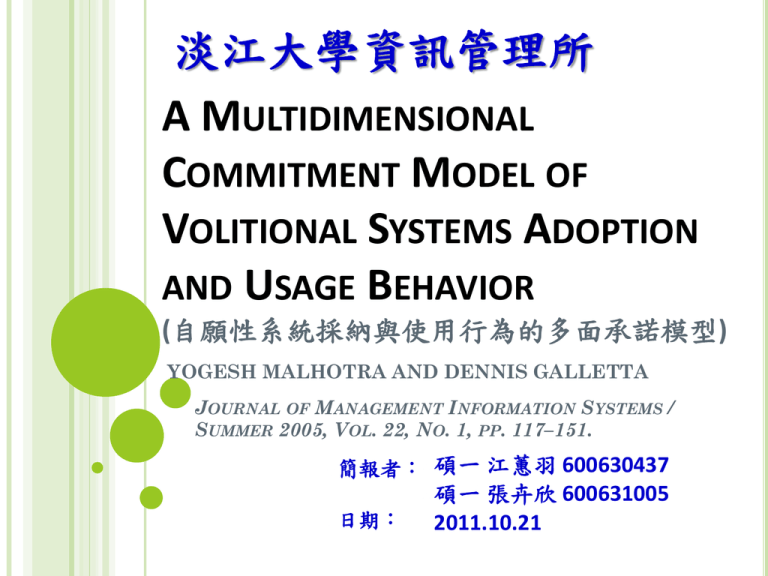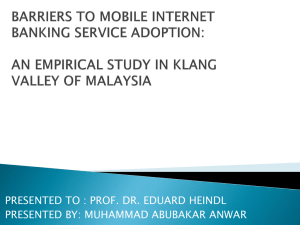A Multidimensional Commitment Model of Volitional
advertisement

淡江大學資訊管理所 A MULTIDIMENSIONAL COMMITMENT MODEL OF VOLITIONAL SYSTEMS ADOPTION AND USAGE BEHAVIOR (自願性系統採納與使用行為的多面承諾模型) YOGESH MALHOTRA AND DENNIS GALLETTA JOURNAL OF MANAGEMENT INFORMATION SYSTEMS / SUMMER 2005, VOL. 22, NO. 1, PP. 117–151. 簡報者: 碩一 江蕙羽 600630437 日期: 碩一 張卉欣 600631005 2011.10.21 CONTENTS Abstract (摘要) Organizational Information System (組織資訊系統) Theory Development (理論的發展) Research Model Research Hypotheses (研究模型與研究假設) Research Methodology (研究方法學) Data Analysis and Findings (數據分析與調查結果) Discussion (討論) Conclusions (結論) 1 ABSTRACT (1/2) A lack of user commitment → Implementation failures. Voluntary systems require users’ volitional behavior. Cross-sectional, between-subjects, and withinsubjects field data were collected from 714 users. (Initial adoption / Six months of extended use) Findings suggest that user commitment plays a critical role in the volitional acceptance and usage of such systems. 2 ABSTRACT (2/2) Affective commitment Internalization and Identification based upon personal norms : exhibits a sustained positive influence on usage behavior. Continuance commitment Compliance based upon social norms : shows a sustained negative influence from initial adoption to extended use. Theory development based upon Kelman’s social influence framework 3 ORGANIZATIONAL INFORMATION SYSTEM Organizational Information System were once primarily used to enforce managerial compliance for the execution of specific work activities. Prior : understanding systems usage behavior from the perspective of social normative compliance How the system user’s own beliefs influence commitment to adopt and use technology. Several surveys and case studies have found : often fail because of the lack of user commitment. 4 THEORY DEVELOPMENT Kelman’s Social Influence Theory (凱爾曼的社會影響理論) Identification, Internalization, and Compliance (認同、內化與順從) Personal Norms and Social Norms (個人規範與社會規範) Affective and Continuance Conceptualizations of Commitment (情感承諾與持續承諾的概念化) 5 THEORY DEVELOPMENT (1/4) Kelman’s Social Influence Theory (凱爾曼的社會影響理論) 6 THEORY DEVELOPMENT (2/4) Identification (認同) Internalization (內化) Compliance (順從) 7 THEORY DEVELOPMENT (3/4) Subjective Norm (主觀規範) Social Norms (社會規範) Personal Norms (個人規範) Behavioral Norms (行為規範) 8 THEORY DEVELOPMENT (4/4) AFFECTIVE AND CONTINUANCE CONCEPTUALIZATIONS OF COMMITMENT Psychological attachment (心理依附) Affective Commitment (情感承諾) Internalization (內化) Identification (認同) Continuance Commitment (持續承諾) Compliance (順從) 9 RESEARCH MODEL AND RESEARCH HYPOTHESES (1/2) 10 RESEARCH MODEL AND RESEARCH HYPOTHESES (2/2) H1a: Perceived usefulness will have a positive influence on attitude toward using the system. H1b: Perceived ease of use will have a positive influence on attitude toward using the system. H1c: Perceived usefulness will have a positive influence on behavioral intention to use the system. H1d: Attitude toward system use will have a positive influence on behavioral intention to use the system. 11 HYPOTHESES ABOUT AFFECTIVE COMMITMENT (1/2) Internalization-Based Commitment H2: Internalization will have a positive influence on users’ behavioral intention to use the system. H3: Internalization will have a positive influence on users’ attitude toward the use of the system. H4: Internalization will have a positive influence on users’ perceived ease of use of the system. H5: Internalization will have a positive influence on users’ perceived usefulness of the system. 12 HYPOTHESES ABOUT AFFECTIVE COMMITMENT (2/2) Identification-Based Commitment H6: Identification will have a positive influence on users’ behavioral intentions to use the system. H7: Identification will have a positive influence on users’ attitudes toward the use of the system. H8: Identification will have a positive influence on users’ perceived ease of use of the system. H9: Identification will have a positive influence on users’ perceived usefulness of the system. 13 HYPOTHESES ABOUT CONTINUANCE COMMITMENT (1/2) Compliance-Based Commitment H10: Compliance will have a negative influence on users’ behavioral intention to use the system. H11: Compliance will have a negative influence on users’ attitude toward the use of the system. H12: Compliance will have a negative influence on users’ perceived ease of use of the system. H13: Compliance will have a negative influence on users’ perceived usefulness of the system. 14 HYPOTHESES ABOUT CONTINUANCE COMMITMENT (2/2) Summary of Hypothesized Relationships Internalization is driven by congruence of a user’s values and personal norms with the induced usage behavior. Identification is based upon his volition for satisfying and self-defining relationships through adoption of such behavior. Compliance (or continuance commitment) users adopt specific behaviors not because they feel it is the right thing to do or they want to do it. 15 RESEARCH METHODOLOGY Focused on understanding usage behavior in the context of a system implementation at two points in time. After initial adoption and use (called the adoption stage). After extended use over six months (called the use stage). 16 ORGANIZATIONAL CONTEXT OF VOLITIONAL SYSTEMS ACCEPTANCE AND USAGE In recent years, organizations have started implementing new types of information and communication systems that depend upon volitional systems usage behavior. The new system was intended to provide a superior technological substitute for self-determined activities of communication, collaboration, and coordination. 17 PROCEDURE AND DATA SAMPLE Distribution and collection of survey questionnaires for both phases was coordinated with the help of the organizational CIO’s office, the system administrator, and the professional trainers. The initial adoption phase yielded 590 usable responses. Yielding 179 usable matched responses for the two phases. 18 MEASUREMENT SCALES The measurement scales for perceived usefulness, perceived ease of use, attitude, and behavioral intention were adapted from Davis. Used an adaptation of the commitment scale developed by O’Reilly and Chatman and empirically validated in several studies. 19 DATA ANALYSIS AND FINDINGS PSYCHOMETRIC PROPERTIES OF MEASURES All scales exhibited high internal consistency reliability, with 0.70 used as the lower cutoff. Construct validity was supported by principal components and maximum-likelihood analyses using both varimax and oblimin rotations with 0.35 as the lower cutoff. Examination of “within-construct” and “crossconstruct” correlations supported the criteria for convergent and discriminant validity. 20 MEASURES FOR COMMITMENT TO SYSTEM USE The correlation matrix containing the Pearson correlations (shown in Table 3) affirms the presence of high correlations of measures within the two factors and low correlations across factors. Item COMP2 seems to capture some elements of social normative compliance as well as some elements of internalization and identification. Hence, for the extended-use analysis, compliance item COMP2 was excluded to improve reliability of the overall continuance (compliance) measure. 21 EXPLAINING BEHAVIORAL INTENTION TO USE THE SYSTEM Perceived usefulness was found to have a strong positive influence on user intentions for both stages, with attitude having a secondary positive influence only at initial use (H1c). Affective commitment (identification and internalization) was found to have a significant positive influence on users’ intentions to use the system (H2 and H6) while compliance was found to have a negative effect (H10). 22 EXPLAINING ATTITUDE TOWARD USE OF THE SYSTEM User commitment based upon internalization and identification had the strongest positive effect on attitude, as hypothesized (H3 and H7). Both perceived usefulness (H1a) and perceived ease of use (H1b) had strong secondary positive influence on attitude at initial system use. Compliance did not exhibit the expected negative effect on attitude at initial or extended use (H11). 23 EXPLAINING PERCEIVED EASE OF USE Identification and internalization were found to have a sustained positive influence on perceived ease of use(H4 and H8). Compliance was found to have a sustained negative influence at initial use and after extended use(H12). 24 EXPLAINING PERCEIVED USEFULNESS Identification and internalization were found to have a sustained strong positive influence on perceived usefulness(H5 and H9). Compliance seemed to have a negative effect on perceived usefulness only at initial use (H13). 25 SUMMARY (1/2) Affective commitment (identification and internalization) had a sustained positive influence on perceived usefulness and ease of use. Affective commitment also positively affected user attitude at initial system use and behavioral intentions over extended use. Continuance commitment (compliance) negatively affected perceived usefulness and perceived ease of use at initial system use, and behavioral intentions and perceived ease of use over extended use. 26 SUMMARY (2/2) 27 FINDINGS ABOUT SYSTEM ACCEPTANCE AND USE (1/2) Perceived usefulness and attitudes are the primary determinants of intentions to adopt the system. Affective commitment (both internalization and identification) has indirect positive influence on behavioral intentions through attitude, perceived ease of use, and perceived usefulness. Continuance commitment (compliance) has a negative influence on behavioral intentions indirectly through perceived ease of use and perceived usefulness. 28 FINDINGS ABOUT SYSTEM ACCEPTANCE AND USE (2/2) At initial adoption, compliance may have indirect negative influence on attitude through perceived ease of use. Over extended system use, perceived ease of use becomes less significant. 29 THEORETICAL CONTRIBUTIONS AND IMPLICATIONS This is an important distinction, given users’ more volitional and autonomous roles in systems oriented toward communication, coordination, and collaboration activities. 30 PRACTICAL IMPLICATIONS Success of such systems thus depends upon users’ “volition” for system use. User commitment has therefore become a key concern for managers implementing such systems. Effective system design thus depends upon keen awareness of the organizational context within which commitment to system use makes sense to users. Even a simple, easy-touse system could fail to deliver results if users do not perceive it as useful in achieving what they perceive as their real goals. 31 LIMITATIONS AND FUTURE RESEARCH Future replications of the research model are needed for generalizing the proposed user commitment construct and its effects on usage behavior for other systems and in other organizational contexts. Future research is also needed to determine if the hypothesized effects about volitional usage behavior are applicable across different types of information systems other than the one discussed in this study. The users’ beliefs, attitudes, and intentions are dynamic and not static from initial adoption to extended use. 32 CONCLUSIONS Findings suggest that user commitment plays a critical role in the volitional acceptance and usage of such systems. 33 淡江大學資訊管理所 A MULTIDIMENSIONAL COMMITMENT MODEL OF VOLITIONAL SYSTEMS ADOPTION AND USAGE BEHAVIOR YOGESH MALHOTRA AND DENNIS GALLETTA JOURNAL OF MANAGEMENT INFORMATION SYSTEMS / SUMMER 2005, VOL. 22, NO. 1, PP. 117–151. Q&A 簡報者: 碩一 江蕙羽 600630437 日期: 碩一 張卉欣 600631005 2011.10.21 34 35









